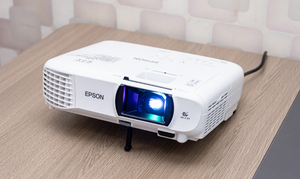
Projection projector inspection method - Inspection and certification services for factory verification and inspection
As a professional display device, the optical performance and quality stability of a projector directly affect the usage effect. To ensure that the product meets industry standards and quality certification requirements, establishing a professional inspection process is of vital importance. This article will systematically introduce the optical performance testing standards, testing methods, and certification requirements for projectors, providing a complete quality control guide for enterprises.
I. Brightness Performance Inspection Certification
1. Brightness Test Certification Standards
Test standard: Adopt the 9-point test method of the ANSI standard
Measurement unit: Lumen (L)
Test principle: Measure the average illuminance of the 9 test points on the screen, and calculate the total luminous flux output.
Certification requirements: The measured brightness value must exceed the nominal value by more than 90%.
2. Brightness Mode Certification
Optimized Brightness: The brightness output after ANSI optimization adjustment
Maximum brightness: The brightness output when the contrast and brightness are adjusted to their maximum values
Certification standard: The brightness in both modes must meet the specification requirements.
II. Contrast Performance Test Certification
1. ANSI Contrast Certification
Test Method: 16-point black and white alternating color block test
Calculation method: The ratio of the average brightness of the 8 white areas to that of the 8 black areas
Certification requirements: Must conform to the stated values in the product specification document.
2. FOFO Contrast Certification
Test Method: Brightness ratio test of full white/full black screens
Characteristic analysis: Usually exceeds the ANSI contrast value
Certification significance: Evaluating performance capabilities in extreme scenarios
3. Contrast Difference Analysis and Certification
Reason for the difference: The inherent characteristics of the projector's optical path design
Certification focus: Both testing methods must meet the basic requirements.
III. Color Performance Inspection and Certification
1. Color Saturation Certification
Definition: The purity and vividness of colored light
Test range: 0 - 100%, pure white light is 0%, pure colored light is 100%
Certification standard: Meets sRGB or higher-level color standards
2. Color gamut range verification
Test method: Measure the color values of the three primary colors (RGB)
Reference benchmark: NTSC color range (sRGB is equivalent to 71% of NTSC)
Certification requirement: Color gamut coverage complies with product specifications
IV. Homogeneity Test Certification
1. Distribution of Test Points Certification
Basic test points: 9 points following the ANSI standard distribution
Expand test points: Add 4 key points at the corners and edges
Certification significance: Comprehensive assessment of the uniformity performance of the image
2. Uniformity of Brightness Certification
Central area: Ratio of the maximum to the minimum illuminance at the 9 o'clock position
Corner area: Ratio of the maximum to the minimum illuminance at 13 points
Acceptable standards:
Center non-uniformity < 1.5
Quality standard < 1.2 (barely detectable to the human eye)
3. Color Uniformity Certification
Test Method: 13-point Color Difference Analysis
Calculation method: Square the deviation of each point from the center point in terms of chromaticity, then take the square root of the sum.
Acceptable standards:
Ideal range: 0.001 - 0.003
Maximum tolerance: ≤ 0.010
V. Noise Level Inspection Certification
1. Test Environment Certification
Preheating requirement: The equipment needs to be preheated for 30 minutes.
Test points: five directions - front, back, left, right, and top.
Test distance: 50 centimeters from the device
Calculation result: The average value of the noise levels in five directions
2. Noise Level Certification
Certification standard: Complies with national noise standards for electronic products
Quality requirements: The working noise should not interfere with the normal operation environment.
VI. Inspection and Certification Process Standards
1. Testing Equipment Certification
Illuminance Meter: A precise instrument that has undergone metrological calibration
Color analyzer: Minolta or equivalent professional equipment
Noise meter: Meets acoustic measurement standards
Equipment calibration: Regular verification to ensure measurement accuracy
2. Test Environment Certification
Darkroom conditions: A darkroom environment that meets the requirements for optical testing
Standard screen: Use standard gain projection screen
Environmental control: Constant temperature and humidity, without vibration interference
3. Sampling inspection plan
Implement statistical sampling in accordance with the AQL standard
The key optical performance items are subject to a full inspection system.
Establish a complete quality traceability system
VII. Key Control Matters for Factory Audit
To ensure that the quality of projectors continues to meet the certification requirements, during the factory audit process, the following matters need to be given special attention:
Optical engine production line certification: Strictly controlling the quality of core optical components
Calibration process control: Establish a standardized color and brightness calibration procedure
Aging test system: Comprehensive machine aging test and performance stability verification
Equipment management for inspection: Regular calibration and maintenance of optical inspection equipment
Technical personnel qualifications: Professional training and certification for optical engineers and quality inspectors
VIII. Continuous Quality Improvement Certification
1. Performance Stability Monitoring
Establish a long-term performance tracking database
Analyze the trend of performance degradation and optimize the product design
Implement preventive quality control measures
2. Customer Experience Optimization
Collect actual user feedback
Incorporate user experience into the quality improvement cycle
Conduct regular market quality surveys
Inspection and Certification Summary
The inspection and factory verification of projection equipment is a highly technical and complex system project that requires comprehensive testing and certification in terms of optical performance, color reproduction, and user experience. By establishing a professional inspection process and strict quality standards, enterprises can ensure that their projection equipment meets industry certification requirements, providing users with accurate color reproduction, sufficient brightness, and stable performance display solutions.
分享这个商品

Projection projector inspection method - Inspection and certification
As a professional display device, the optical performance and quality stability of a projector directly affect the usage effect.
